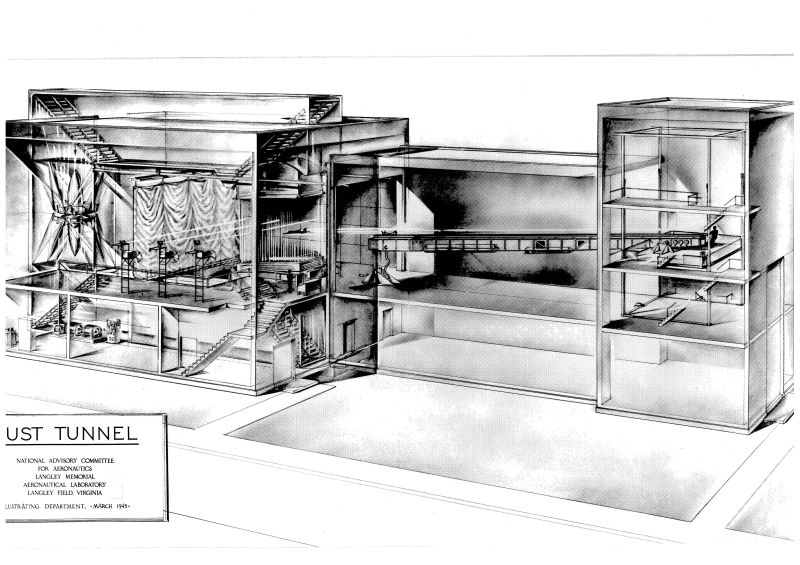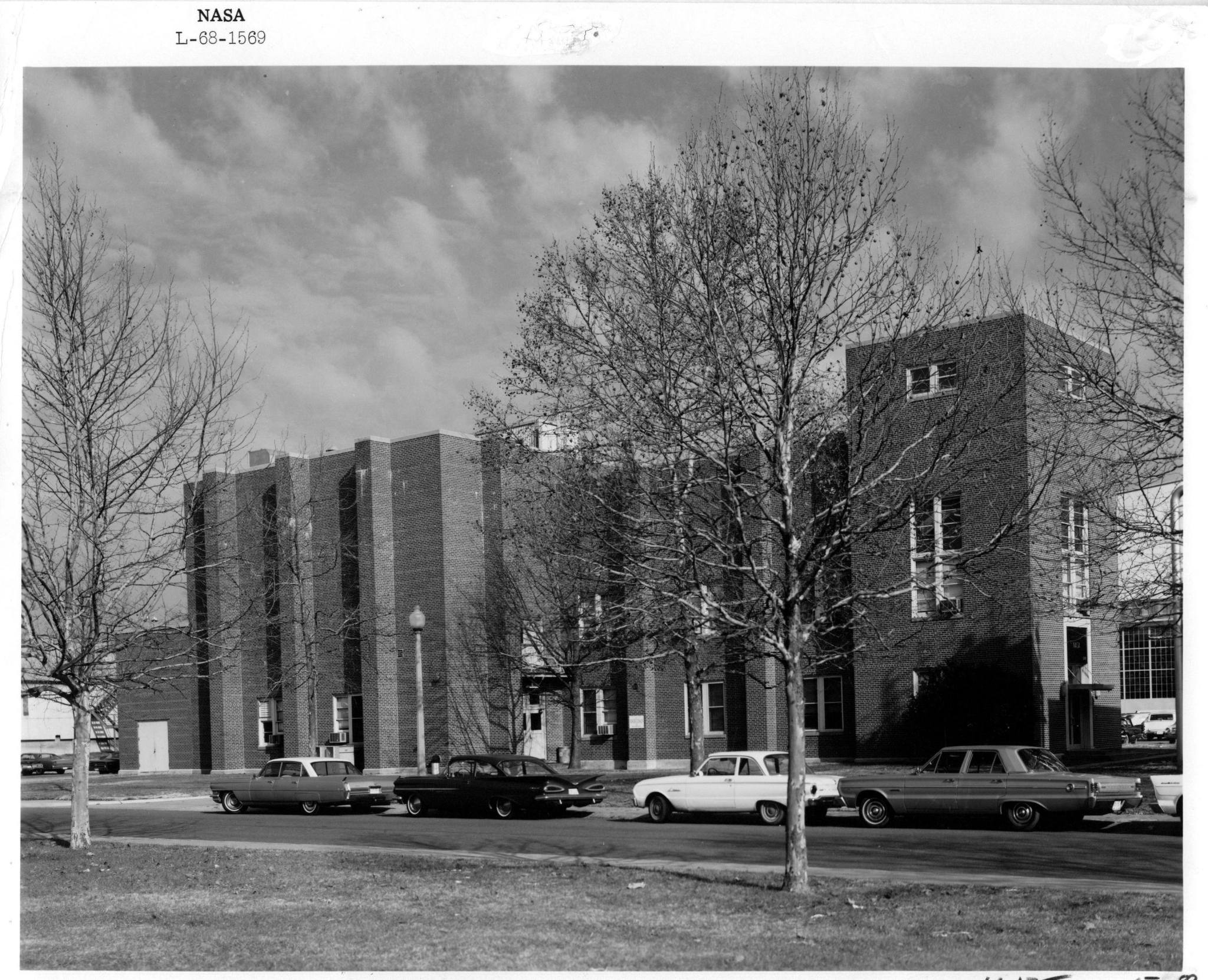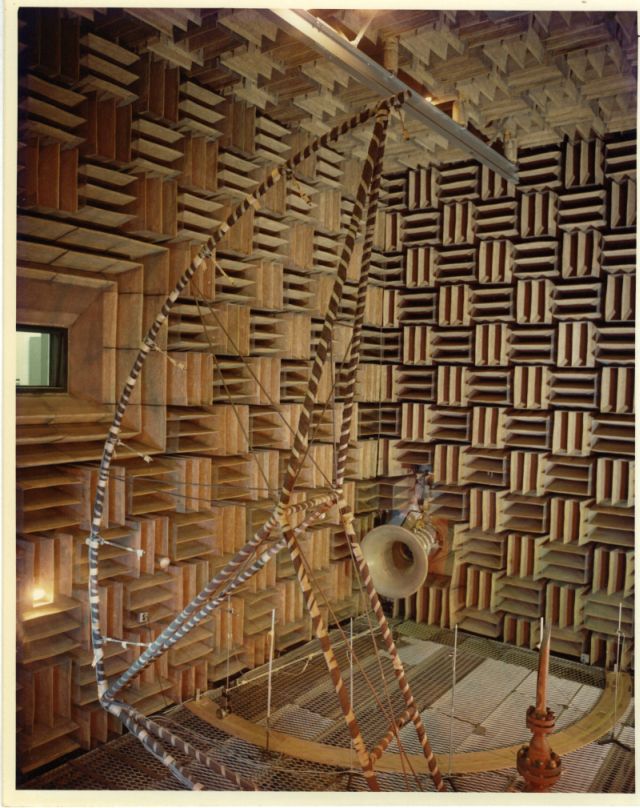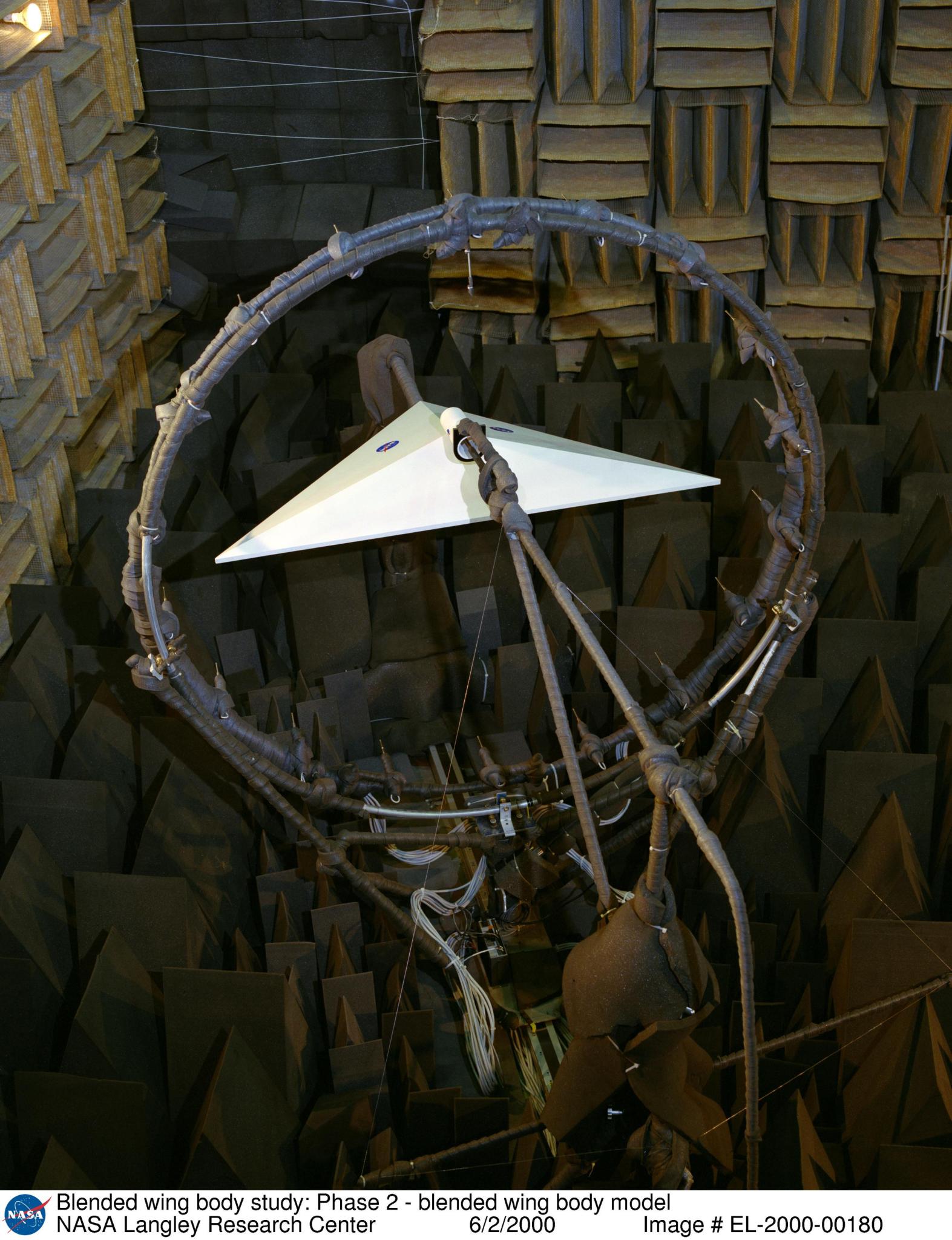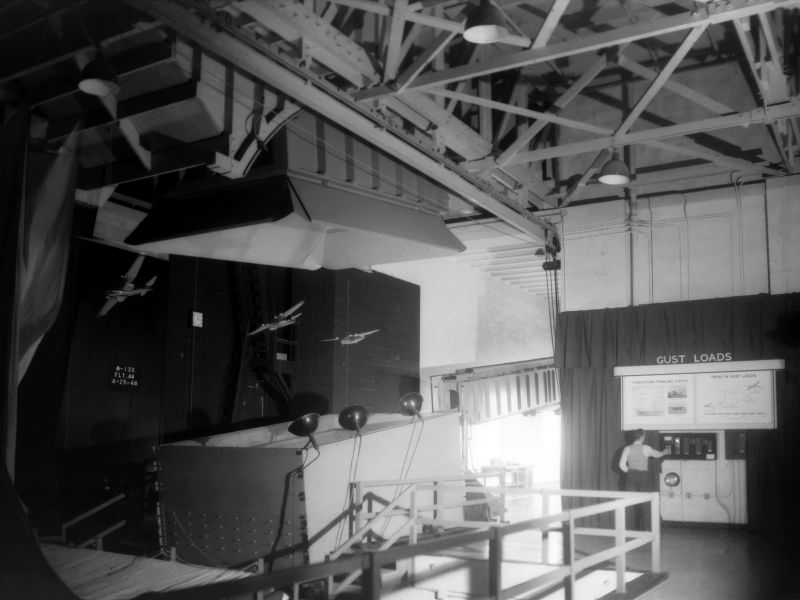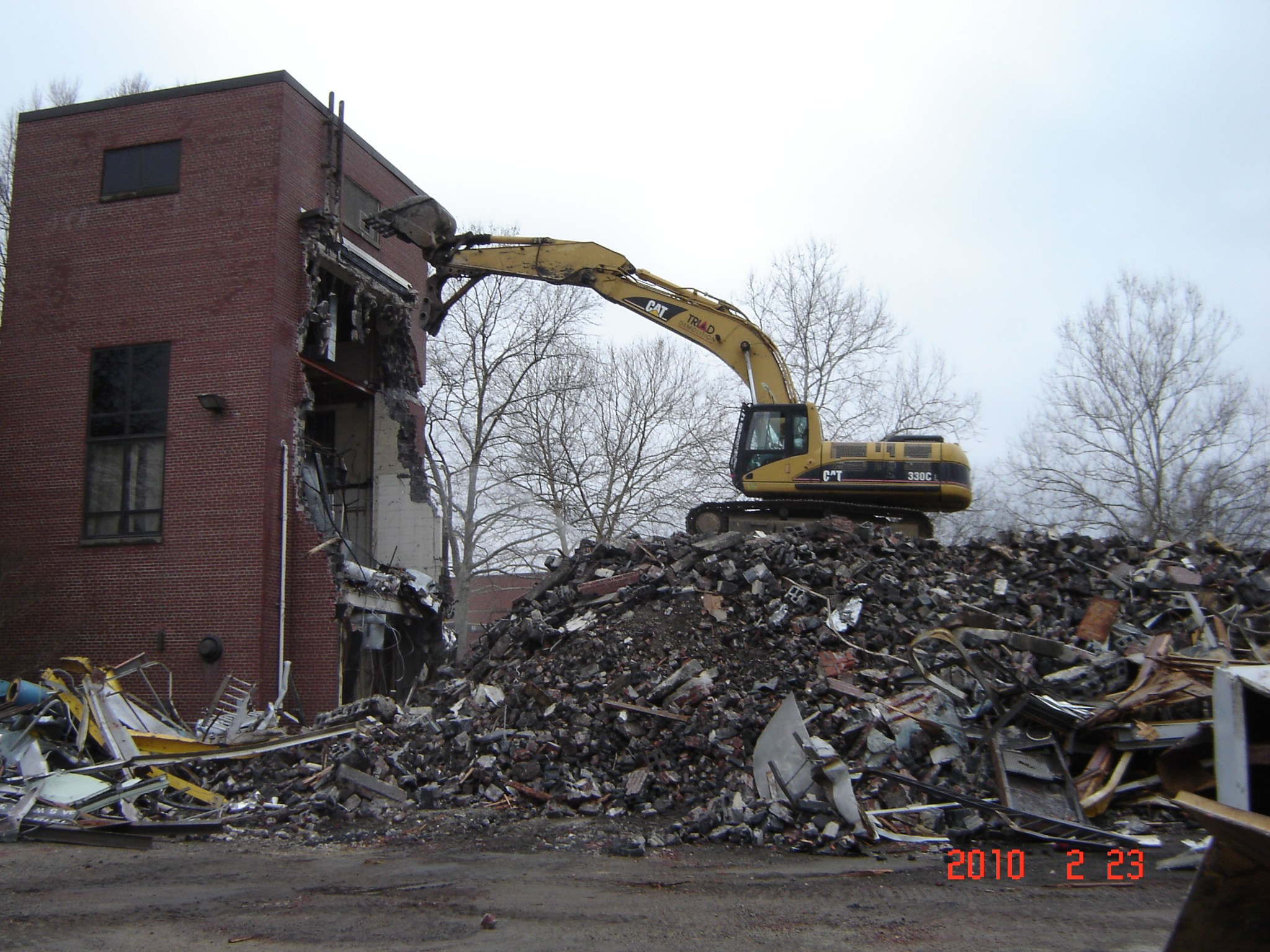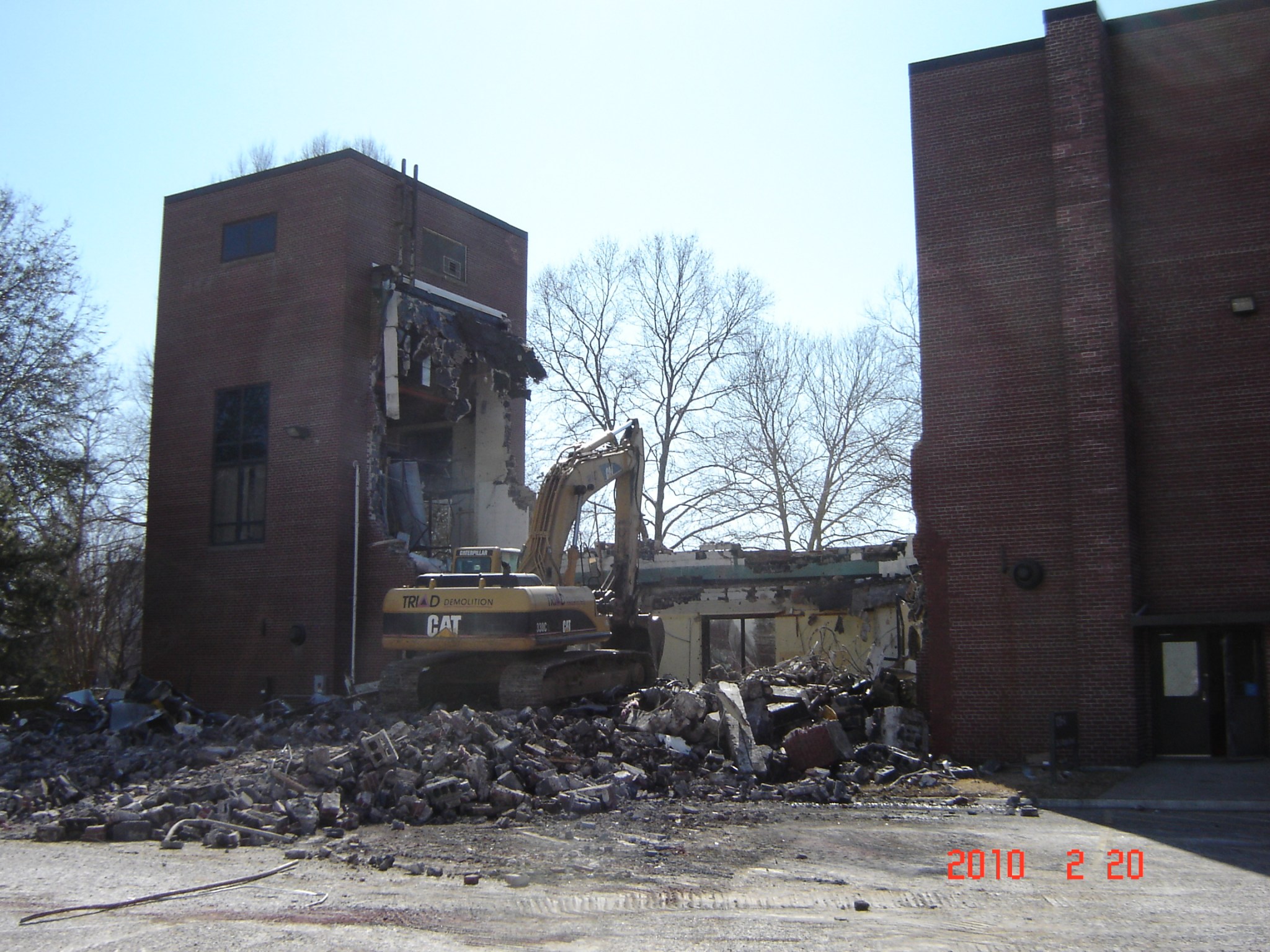Quick Facts
Year Built: 1945
Historic Eligibility: National Register Eligible
Year Demolished: 2010
History
Building 1218 was constructed in August 1945 for the purpose of conducting experiments on gust loads using free-flight models catapulted through a vertical airstream. When the gust research activity was terminated in the mid-1950s, the building occupancy was divided between research office space (designated Building 1218) and an anechoic test facility (designated Building 1218A).
The anechoic test capability was retained through 2009, while the office areas were subsequently converted to an Executive Conference Center.
Gust Tunnel
The aircraft design process devotes considerable time to ensure that the airframe structure will be the lightest and most acceptable approach to meeting requirements based on in-flight and ground-induced structural loads.
One traditional challenge has been the development and validation of technical methods to predict air loads experienced during flight in gusts and turbulence. This capability is extremely important, not only from a safety-of-flight perspective, but also to prevent an overdesign of aircraft structures which would result in unnecessarily large weight penalties.
Early research in the 1920s and 1930s at the NACA Langley laboratory included theoretical studies of loads generated in specific gust fields, but flight data to substantiate the predictions was extremely difficult to obtain at that time.
In order to experimentally investigate gust loads under controlled conditions, in 1937 the NACA designed and constructed a pilot Gust Tunnel within an area of the Langley Full-Scale Tunnel (Building 643) outside the tunnel flow circuit. This pilot Gust Tunnel facility operated in the NACA East Area for almost a decade.
The pilot Gust Tunnel testing technique consisted of launching dynamically scaled, free-flight airplane models through gusts of known shapes and intensities. During the flight, measurements were made of the accelerations and reactions of the models due to the gusts. The test facility consisted of a gust generator, a catapult for launching the models, and two screens used to decelerate and catch the airplane model at the end of the flight.
The gust generator was a large squirrel-gauge blower which supplied air to an expanding rectangular channel discharging a current of air upward. The vertical jet of air was 6-feet wide and 8-feet long and its air speed was controlled by combinations of screen meshes designed to produce the desired gust shape. Technical reports about the work done in these facilities can be found on the NASA Technical Reports Server. Examples include:
After the catapulted airplane model completed its flight through the vertical-gust field, it impacted a barrier of vertical rubber strands which decelerated the model. After deceleration, the model nose (shaped like a barbed hook) engaged a burlap screen which stopped the model and held it until it could be removed by the tunnel operator. The propelling catapult was powered by a dropping weight, and the maximum model flight speed was adjustable by changing the amount of weight. The facility was capable of testing scaled airplane models having wings spanning about 3-feet and at speeds up to about 50 mph.
The pilot Gust Tunnel produced very valuable information on gust loads as affected by primary aircraft design variables, and results from the facility were used to justify reducing the structural design criteria that had led to overdesign of wing structures for certain types of aircraft configurations.
In 1945 the pilot Gust Tunnel was replaced by a new Langley Gust Tunnel which was similar in operational concept, but capable of testing larger 6-foot span models at speeds up to 100 mph. The facility was housed in a new building (Building 1218) in the Langley West Area.
The catapult launch mechanism was located at the front of the building with an open-jet wind tunnel located in a larger building segment at the rear. After passage through the vertical open jet, the test model impacted a vertical curtain.
Tests conducted in the new tunnel covered a wide range of emerging aircraft geometries including swept-back wings, and studies were made of the effects of aircraft structural frequencies and gust-load alleviation concepts. Operations of the Gust Tunnel continued into the 1950s until the introduction of high-flying jet transport aircraft.
Flight of jet transports at high altitudes minimized the potential for gust encounters and thereby reduced the demand for continued NACA research on the topic. In addition, the limited speed capability and relatively small models used in the Gust Tunnel were viewed as major shortcomings for research on large jet transport aircraft. With its operational mission no longer justified, the Langley Gust Tunnel was dismantled in the late 1950s. In its last operational years, the facility had also been used briefly to test instrumentation at low speeds.
During its operational status, the Gust Tunnel’s staff was located in nearby Building 1219 (Aircraft Loads Laboratory) along with other organizations conducting loads research. In 1956, Langley’s Senior Staff was moved from the East Area into Building 1219 and all the loads-related organizations moved to Building 1229 (Physical Research Laboratory).
Anechoic Noise Research Laboratory
With the gust research mission and equipment removed from the building, other research organizations became tenants. As part of the growing Langley role in acoustics and noise reduction, the Langley Anechoic Noise Research Laboratory, a 27 by 27 by 27-foot acoustic test chamber, was constructed in the rear of the building and designated Building 1218-A. The acoustic wedges in the chamber were 3 feet deep on the walls, floor and ceiling.
The Langley Anechoic Noise Research Laboratory became operational in June 1962 and its staff was located in building 1229. The lab continued operations for 47 years until Building 1218 closed in 2009.
In its original configuration, the facility used a noise generator apparatus consisting of a propane burner and an exhaust nozzle diameter from 1 to 6 inches. Acoustic measurements were made via microphones on a rotating boom. A second-floor open area was used for model preparation and auxiliary experiments, along with a control room that included data acquisition systems and controls for the air system.
The facility evolved into an open-circuit, high-pressure, air-driven anechoic wind tunnel. Two modes of operation were provided, the first of which was a vertical-flow path through the anechoic chamber used for aeroacoustic studies of nozzles and noise created by the interactions of aerodynamic flows and solid surfaces. The second operational mode used supplied air to drive a 1000 hp air turbine of a ducted propeller engine demonstrator.
The scope of aeroacoustic research conducted in the facility included: jet engine fan noise studies; concepts for active noise control; airframe noise studies of advanced aircraft configurations; microphone array technology for advanced instrumentation and data acquisition; and the effects of engine duct configuration on noise.
Tests included the development and use of several unique test apparatuses and instrumentation. In the 1980s, a high-power fan was fabricated outside the anechoic chamber with the fan inlet projecting into the chamber. The purpose was to quantify inlet-radiated noise and fan noise generation mechanisms. When this research area was completed, the fan was removed and the hole in the anechoic chamber wall was filled in.
In another example of test methodology, a 12-inch diameter, high-pressure air-turbine-driven demonstrator based on a Pratt & Whitney Advanced Ducted Propeller engine was fabricated, used for tests in the Langley 14- by 22-foot tunnel and also installed in the Anechoic Noise Research Laboratory. It was used primarily as a test bed for development of inlet-radiated noise measurement and noise control method studies.
Other Tenants
While the rear of Building 1218 was used for aeroacoustic research, the front of the building housed two floors of offices used by other research organizations through the mid-1960s. The staff of the Langley 9-Inch Supersonic Tunnel had moved from Building 1191 to Building 1219 in the 1950s, but in 1956 when Building 1219 became the headquarters facility, the staff was moved to Building 1218. The main thrust of the group was in hypersonic tunnels and they subsequently moved to the complex of Building 1247A.
In the mid-1960s, the front lower- and upper-floor offices of Building 1218 were refurbished as an executive meeting center and functioned as such until the building closed. The building was demolished in 2010.
Technical reports about the work done in these facilities can be found on the NASA Technical Reports Server (NTRS). Examples include:
- Summary of Information Relating to Gust Loads on Airplanes – NASA Technical Reports Server (NTRS)
- Gust-tunnel Investigation of a Wing Model with Semichord Line Swept Back 60 Degrees – NASA Technical Reports Server (NTRS)
- Gust-tunnel Investigation of the Effect of Leading Edge Separation on the Normal Accelerations Experienced by a 45 Degree Sweptback-wing Model in Gusts – NASA Technical Reports Server (NTRS)
- Gust-tunnel Investigation of the Effect of a Sharp-edge Gust on the Flapwise Blade Bending Moments of a Model Helicopter Rotor – NASA Technical Reports Server (NTRS)
Related Materials
- Gust Tunnel – Operation to Begin November 1944
- Vertical Section View of Anechoic Noise Research Facility
- 2002 Anechoic Noise Facility
- 2010 Floor Plan


























